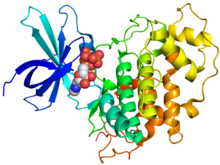| Glycogen synthase kinase 3, catalytic domain | |
|---|---|
| Identifiers | |
| Symbol | STKc_GSK3 |
| InterPro | IPR039192 |
| CDD | cd14137 |
| glycogen synthase kinase 3 alpha | |||||||
|---|---|---|---|---|---|---|---|
| Identifiers | |||||||
| Symbol | GSK3A | ||||||
| NCBI gene | 2931 | ||||||
| HGNC | 4616 | ||||||
| OMIM | 606784 | ||||||
| RefSeq | NM_019884 | ||||||
| UniProt | P49840 | ||||||
| Other data | |||||||
| EC number | 2.7.11.26 | ||||||
| Locus | Chr. 19 q13.2 | ||||||
| |||||||
| glycogen synthase kinase 3 beta | |||||||
|---|---|---|---|---|---|---|---|
 Crystallographic structure of human GSK-3β (rainbow colored, N-terminus = blue, C-terminus = red) bound to phosphoaminophosphonic acid-adenylate ester (spheres).[1] | |||||||
| Identifiers | |||||||
| Symbol | GSK3B | ||||||
| NCBI gene | 2932 | ||||||
| HGNC | 4617 | ||||||
| OMIM | 605004 | ||||||
| PDB | 1Q3W More structures | ||||||
| RefSeq | NM_002093 | ||||||
| UniProt | P49841 | ||||||
| Other data | |||||||
| EC number | 2.7.11.26 | ||||||
| Locus | Chr. 3 q13.33 | ||||||
| |||||||
Glycogen synthase kinase 3 (GSK-3) is a serine/threonine protein kinase that mediates the addition of phosphate molecules onto serine and threonine amino acid residues. First discovered in 1980 as a regulatory kinase for its namesake, glycogen synthase (GS),[2] GSK-3 has since been identified as a protein kinase for over 100 different proteins in a variety of different pathways.[3][4] In mammals, including humans, GSK-3 exists in two isozymes encoded by two homologous genes GSK-3α (GSK3A) and GSK-3β (GSK3B). GSK-3 has been the subject of much research since it has been implicated in a number of diseases, including type 2 diabetes, Alzheimer's disease, inflammation, cancer, addiction[5] and bipolar disorder.
GSK-3 is a serine/threonine protein kinase that phosphorylate either threonine or serine, and this phosphorylation controls a variety of biological activities, such as glycogen metabolism, cell signaling, cellular transport, and others.[6] GS inhibition by GSK-3β leads to a decrease in glycogen synthesis in the liver and muscles, along with increased blood glucose or hyperglycemia.[7] This is why GSK-3β is associated with the pathogenesis and progression of many diseases, such as diabetes, obesity, cancer,[8] and Alzheimer's disease.[9] It is active in resting cells and is inhibited by several hormones such as insulin, endothelial growth factor, and platelet-derived growth factor. Insulin indirectly inactivates GSK3 via downstream phosphorylation of the specific serine residues Ser21 and Ser9 in GSK-3 isoforms α and β, respectively via the PI3K/Akt pathway.[10][11]
As of 2019[update], GSK-3 is the only type of glycogen synthase kinase named and recognized. The gene symbols for GSK1 and GSK2 have been withdrawn by the HUGO Gene Nomenclature Committee (HGNC), and no new names for these "genes" nor their locations have been specified.[12][13]
- ^ PDB: 1J1B; Aoki M, Yokota T, Sugiura I, Sasaki C, Hasegawa T, Okumura C, et al. (March 2004). "Structural insight into nucleotide recognition in tau-protein kinase I/glycogen synthase kinase 3 beta". Acta Crystallographica. Section D, Biological Crystallography. 60 (Pt 3): 439–446. Bibcode:2004AcCrD..60..439A. doi:10.1107/S090744490302938X. PMID 14993667.
- ^ Embi N, Rylatt DB, Cohen P (June 1980). "Glycogen synthase kinase-3 from rabbit skeletal muscle. Separation from cyclic-AMP-dependent protein kinase and phosphorylase kinase". European Journal of Biochemistry. 107 (2): 519–527. doi:10.1111/j.1432-1033.1980.tb06059.x. PMID 6249596.
- ^ Beurel E, Grieco SF, Jope RS (April 2015). "Glycogen synthase kinase-3 (GSK3): regulation, actions, and diseases". Pharmacology & Therapeutics. 148: 114–131. doi:10.1016/j.pharmthera.2014.11.016. PMC 4340754. PMID 25435019.
- ^ Jope RS, Johnson GV (February 2004). "The glamour and gloom of glycogen synthase kinase-3". Trends in Biochemical Sciences. 29 (2): 95–102. doi:10.1016/j.tibs.2003.12.004. PMID 15102436.
- ^ Turlik J, Wąsikiewicz E, Domaradzka A, Chrostek G, Gniadzik W, Domagalski M, Duda P (December 2021). "GSK3β Activity in Reward Circuit Functioning and Addiction". NeuroSci. 2 (4): 443–466. doi:10.3390/neurosci2040033. ISSN 2673-4087.
- ^ Pandey MK, DeGrado TR (2016). "Glycogen Synthase Kinase-3 (GSK-3)-Targeted Therapy and Imaging". Theranostics. 6 (4): 571–593. doi:10.7150/thno.14334. PMC 4775866. PMID 26941849.
- ^ Ali A, Hoeflich KP, Woodgett JR (August 2001). "Glycogen synthase kinase-3: properties, functions, and regulation". Chemical Reviews. 101 (8): 2527–2540. doi:10.1021/cr000110o. PMID 11749387.
- ^ Eldar-Finkelman H (March 2002). "Glycogen synthase kinase 3: an emerging therapeutic target". Trends in Molecular Medicine. 8 (3): 126–132. doi:10.1016/S1471-4914(01)02266-3. PMID 11879773.
- ^ Hooper C, Killick R, Lovestone S (March 2008). "The GSK3 hypothesis of Alzheimer's disease". Journal of Neurochemistry. 104 (6): 1433–1439. doi:10.1111/j.1471-4159.2007.05194.x. PMC 3073119. PMID 18088381.
- ^ Hermida MA, Kumar JD, Leslie NR (August 2017). "GSK3 and its interactions with the PI3K/AKT/mTOR signalling network". Advances in Biological Regulation. 65: 5–15. doi:10.1016/j.jbior.2017.06.003. PMID 28712664. Retrieved 15 December 2023.
- ^ Li Q, Zhao Q, Zhang J, Linkang L, Wenhao W, Chua B, Chen Y, Xu L, Li P (September 24, 2019). "The Protein Phosphatase 1 Complex Is a Direct Target of AKT that Links Insulin Signaling to Hepatic Glycogen Deposition". Cell Reports. 28 (13): 3406–3422. doi:10.1016/j.celrep.2019.08.066. PMID 31553910.
- ^ Glycogen+synthase+kinase at the U.S. National Library of Medicine Medical Subject Headings (MeSH)
- ^ GSK1, GSK2. NCBI Gene.